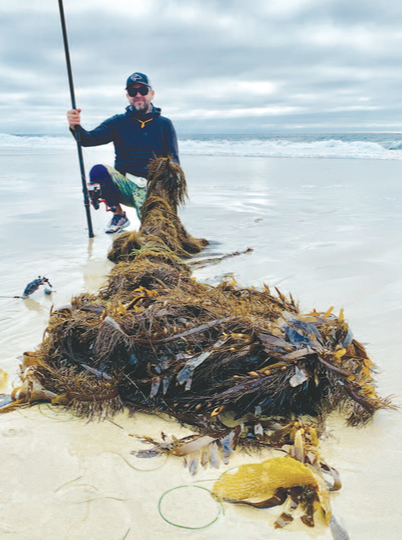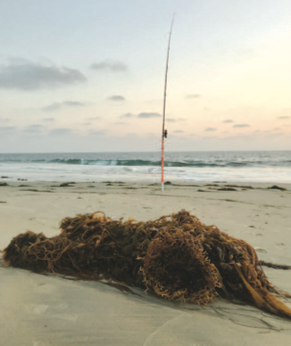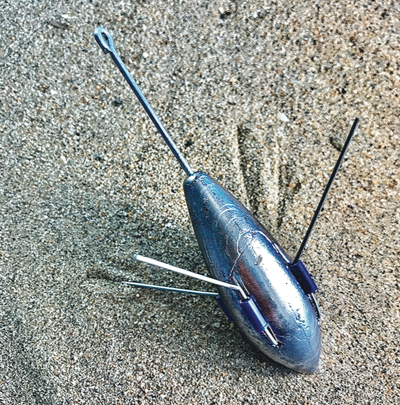
BY BEN HERVEY-MURRAY
This season is one of my favorite surf fishing periods because the beaches are quieter, the water temperatures remain useful for a mix of species and, if you are targeting predators after dark, the clocks changing mean longer surfer-free sessions before the beaches or parking lots close in the late evening.
However, challenging conditions often put people off and a regular comment I hear as a guide when asking clients about what aspect of surf fishing they find hardest, is that lots of weed and kelp in the surf just kills their sessions at certain times of the year. And they’re right — giant kelp (Macrocystis pyrifera) and their grassy cousins can be a nightmare to deal with, but a lot of the issues experienced can be mitigated by following a few simple strategies and tackle tweaks.
We’ll explore the subject through the lens of surf shark fishing because this is when, in my experience, effectively dealing with kelp becomes really important in catching your target, but you can apply the same lessons and tactics to any form of surf fishing, light or heavy. The combination of the tactics detailed below and a good mindset will allow you to make the most of even the kelpiest of days.
THE RIGHT SAND SPIKE
Let’s start with the placement and type of rod holder. The main requirements for a rod

holder when fishing a beach with a bit of kelp about is for it to be as far off the sand as possible and immovable. I see lots of people using the tiny metal spikes with a cup and V-shaped rod holder that holds the combo a foot or two off the sand. These are fine for light bait-and-wait fishing for species like croaker and perch, but involve any bigger fish or weedy water and they’ll soon be folding over under pressure and giving your reel a sand bath. I’ve seen a leopard shark bend one of the most commonly used spikes of this design into a 45-degree angle on the take — a decent soupfin, sevengill or bat ray will do worse and you’ll lose your rod.
The best option for any sort of heavy-duty West Coast surf fishing is 1.5-inch white PVC pipe cut into five-foot lengths. Get it from your local DIY store for less than ten bucks for a ten-foot length and chop it in half to form a sharp angle that’ll facilitate driving it in nice and deep, until it’s rock solid. Take a rubber mallet to the beach, position your spike just above the surfline, taking care to drive in straight down, and hammer until it’s impossible to rip out.
As the tide moves in or out, keeping that spike and rod set with a very straight tight line (not off to either side) down to the sinker, and keeping it positioned on the surfline — as close to the water as I can get it without getting too wet — is key. This is because most free-floating kelp gets into the shore break surf where the waves are turning over, and gets on your main line when it intersects with this zone. By keeping the sand spike and rod close to this kelpy surf, you’re using the length of the rod to get as much of the line as possible out of this danger zone and hopefully straight out into the clearer water just behind the kelpy churn.
Regularly moving the spike and rod position to keep it close to the surf zone is important, too. Leave it in the same place as the tide goes out, and you’ll quickly find the weedy zone moving back with the tide and interacting with your set up a lot more if you leave it in place back up the beach. Obviously with an incoming tide, you need to move it back regularly to keep it accessible and not swamped, but still in that area closest to the water.
Being the kind of angler who likes to actively solve problems rather than shrug and give up really helps in this situation — be prepared to get into the water every few minutes to pull and cut smaller bits of kelp off the line rather than just leaving it. When one lump weighs the line down and lowers the angle into the surf, it’s far more likely to pick up even more weed as a result.
ROD AND REEL CHOICES
For similar reasons that make choosing a long and substantial surf spike a wise move, a heavy-duty surf rod in the 12 to 14 range is your friend in kelpy conditions. Too short a rod and you change that line angle so it hits the churn zone more often, meaning fast wipeouts thanks to the green monster. Anything less than 12 foot will make life hard and, with plenty of good options costing around $100, a decent and very usable 13-foot surf rod combo is affordable for many.
Obviously, the reel should be matched to the rod, and I use 6000- to 8000-size spinning reels (currently, Penn and Daiwa models) loaded with 40-, 50- or 60-pound eight-strand braid for most heavy-duty surf fishing, with the 50- and 60-pound- equipped models (e.g. a Penn Slammer III 8500) the best bet for handling kelp. I always use a 12- to 14-foot mono casting or rubbing leader too, usually made from 80-pound mono. I urge you to do the same for many reasons.
You have to consider that you’re likely to encounter giant kelp fronds weighing tens of pounds, sometimes more. Person-sized rafts in the surf zone are common and my procedure for handling big branches that have got hung up and dragged the sinker significantly downcurrent, is to handline the whole lot most of the way in to avoid breakages (heavy kelp is notorious for breaking tip guides and braided main line…) .
First, you must wear gloves if you handline braid unless you like cheese-wired hands. I carry at least two stab-proof work gloves and a spare in my pocket at all times along with pliers, a sheathed knife and scissors. By hand lining the bigger chunks of kelp to the beach, you’re saving a lot of pressure on your rod and reel, particularly in the last few meters when the suck and pull of the surf can create an unstoppable mass, which you can simply let go of if the pressure is too much.
In this situation, I keep my rod in the spike with the drag set lightly so it can give line if needed, with me out front in the surf hauling in whatever nightmarish congealment has hung itself on my main line. The scissors and knife are handy for cutting off those big stems and I have friends who also employ a gaff to grab those bits sitting just out of reach, which is handy if the surf is rough. Expect to get wet regardless.
Once you’ve removed the kelp from the line and deposited it out of harm’s way, pay careful attention to your main line and reel. Giant kelp often comes packaged with various hitchhiking mussels, gnarly old root systems and other abrasive detritus, which slice through braid main line like a knife. But with tough-as-old-boots mono doing the heavy lifting at the business end of the set up as you haul it back through the surf, cutoffs are minimal and your hands will thank you for the mono when it comes to dragging the whole sorry mess back up the sand.
Next, and assuming you’re using braid main line, carefully pull off any line that’s been loosely wound onto the reel during the process of dealing with a kelp attack. Walk down the beach to get the line off the reel without it sitting in a pile,
all the time feeling and looking at the braid for signs of damage from those sharp elements. Retie and discard any damaged sections if necessary. Then reel the line back on as tight as you can manage through a gloved hand, making sure it’s free of any small strands of weed.
This may seem like a bit of hassle but one of the most common things to happen after a kelp invasion is for line to not be reeled back on properly in the process. A loose section, knot or little dropped loop in the main line finds its way onto the reel, and then easily translates into one of those annoying braid knots on the cast, which isn’t ideal when launching eight-ounce sinkers and big baits. Even worse, you hook up on a decent fish next cast and it quickly goes ping where the braid has been damaged and you didn’t notice. I’ve seen this happen with friends who aren’t careful about the state of their main line and it’s heartbreaking.

SINKER SELECTION IS VITAL
Another area where lots of people make fundamental mistakes is in choosing the wrong style of sinker. If you’re bait and wait surf fishing with any sort of weed in the water, you really want to be using a spiked surf sinker, also known as a Sputnik due to the long wire arms. The arms on the sinker dig into the bottom and anchor the rig with even quite large bits of kelp on the line, but pop out with a little more pressure. I also believe that this style of sinker aids hooking a fish, particularly when combined with a circle hook and pulley-style rig. Storm or pyramid-style sinkers are not adequate for fishing in kelp, weed, current or surf. They simply get washed down the beach as soon as any sort of greenery or current hits your main line.
For surf shark fishing in Southern California, for example, I use 7- and 8-ounce Sputnik sinkers exclusively and find that going a little heavier by an ounce in sinker size helps pin it out there in kelpy conditions too. I’m trying to maximize the time my bait and fresh bloody scent trail is out there, uninterrupted and unmoved from its initial position, giving fish the maximum chance of finding it and hooking up.
A great tip is to carry some small plastic zip ties and use these to secure the sinker wires
in position so they can’t fold open and lose grip. With lots of pressure on the line, the wires can fold open, especially if there’s substantial current and waves too, but securing them in this way will buy extra time in the bite zone. This trick has definitely caught some bonus fish for my clients when conditions have been tough and even an eight-ounce sinker isn’t holding in place for long.
GOOD TIMING HELPS
The days after a storm or big swell are always worst for kelp in the surf, with loose strands breaking free and drifting to shore over subsequent tide cycles. Beaches adjacent to reefs and kelp forests will always be badly affected by this kind of event and should be avoided in such conditions.
The tide cycle you fish also matters. A big incoming or outgoing tide, although great for the fish, can be a challenging as the mass of weed gets sent towards the beach, before being dragged back out the same way when the tide changes. Smaller tide cycles will result in less kelp moving, as will times when a low or slacker tide has left the big chunks stranded up the beach and away from your lines.
Often, you’ll find the weed situation is bad for an hour or two as the tide kicks into action, with conditions easing as the tide moves the kelp out of the surf zone. A bit of patience can solve the issue when all seems lost.
Having said that, there have been a handful of days when I’ve scouted an area before a trip and it’s pretty obvious that it’s a waste of time with multiple giant balls of kelp wiping rods out within seconds of casting out.
Pick your battles — 90% of the time the weed situation is manageable, but be prepared to cut your losses and switch beaches or go another day if the result is likely to be endless frustration and broken equipment. Otherwise, don’t be defeated – the fish will be there, make sure you are too.


